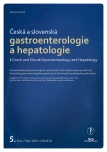Treatment of patients with acute pancreatitis in the Slovak Republic – survey
Authors:
M. Huťan 1; J. Payer Jr 2; M. Huťan Jr 3
Authors‘ workplace:
IV. chirurgická klinika LF UK a FNsP Bratislava 2Klinika plastickej chirurgie LF UK a FNsP Bratislava 3II. chirurgická klinika LF UK a FNsP Bratislava
1
Published in:
Gastroent Hepatol 2010; 64(5): 4-9
Category:
Original Article
Overview
Design:
To ascertain the extent of treatment provided to patients with acute pancreatitis in surgical departments across the Slovak Republic and to compare these results with those of the pan-European study. Methods: 57 questionnaires were sent to surgical departments in Slovakia of which 34 were sent back filled in, i. e. a response-rate of 59.65%. Results: The most frequent number of patients with acute pancreatitis treated at the departments ranged from 51 to 60 patients per year (this answer was chosen by 20.59% of involved departments). CRP (C-reactive protein) levels (85.29%) followed by clinical state assessment (79.41%) were the most commonly used stratification systems. Antibiotic prophylaxis and initial CT examination were applied by only 41.18% and 29.41% of the respondents, respectively. A lack of improvement in the patient’s clinical state was considered an absolute indication for a repeated CT scan examination in all 34 of the involved departments. FNA (fine needle aspiration) to prove pancreatic necrosis infection was only performed by 11.76% of the surgical departments in the Slovak Republic. Surgical intervention was most frequently (in 76.47%) indicated in patients with organ dysfunction and sepsis symptoms, with 38.24% of departments seeing an optimal surgery time between day 15 and 21 after onset of the illness. As many as 44.12% of the respondents would treat a pancreatic abscess with surgical evacuation followed by the creation of a closed drainage system. Pancreatic necrosis would be dealt with identically by one-half of the departments.
Key words:
acute pancreatitis – questionnaire survey – illness staging – timing – surgical treatment
Sources
1. Balthazar EJ. Imaging and intervention in acute pancreatitis. Radiology 1994; 193(2): 297–306.
2. Banks PA, Freeman ML. Practice Guidelines in acute pancreatitis. Am J Gastroenterol 2006; 101(10): 2379–2400.
3. Bradley EL. A Clinically Based Classification System for Acute Pancreatitis. Summary of the international Symposium on Acute Pancreatitis, Atlanta, Ga, September 11 through 13, 1992. Arch Surg 1993; 128(5): 584–590.
4. Sarr MG. IAP Guidelines in Acute Pancreatitis. Dig Surg 2003; 20 (1): 1–3.
5. Hollender LF, Lehnert P, Wanke M. Akute Pankreatitis – Eine multidisciplinare Synopsis. Leipzing, J.A. Barth, 1984 : 175.
6. Fernández-del Castillo C, Rattner DW, Makary MA et al. Débridement and closed packing for the treatment of pancreatitis. Ann Surg 1998; 228(5): 676–684.
7. Imrie CW, Benjamin IS, Ferguson JC et al. A single centre double blind trial of trasylol therapy in primary acute pancreatitis. Br J Surg 1978; 65(5): 337–341.
8. Knaus WA, Draper EA, Wagner DP et al. APACHE II: a severity of disease scoring system. Crit Care Med 1985; 13(10): 818–829.
9. Uhl W, Warshaw A, Imrie C, et al. IAP Guidelines for the Management of Acute Pancreatitis . Pancreatology 2002; 2(6): 565–573.
10. Nathens AB, Curtis JR, Beale RJ et al. Management of the critically ill patients with severe acute pancreatitis . Crit Care Med 2004; 32(12): 2524–2536.
11. King NK, Siriwardena AK. European Survey of Surgical Strategies for the Management of Severe Acute Pancreatitis Am J Gastroenterol 2004; 99(4): 719–725.
12. Foitzik T, Klar E. (Non-)compliance with Guidelines for the Management of Severe Acute Pancreatitis among German Surgeons. Pancreatology 2007; 7(1): 80–85.
13. Ranson JH, Rifkind KM, Turner JW. Prognostic signs and nonoperative peritoneal lavage in acute pancreatitis. Surg Gynecol Obstet 1976; 143(2): 209–219.
14. Mazaki T, Ishii Y, Takayma T. Meta-analysis of prophylactic antibiotic use in acute necrotising pancreatitis. Br J Surg 2006; 93(6): 674–684.
15. Olejník J, Brychta I. Aktuálny antimikrobiálny manažment ťažkej akútnej pankreatitídy. Slovenská chirurgia 2008; 5(3): 16–21.
16. Vyhnánek F, Vyhnánková I. Postup u těžké formy akutní pankreatitidy – současný stav. Anest intenziv Med 2008; 19(1): 47–53.
17. Haney JC, Pappas TN. Necrotising Pancreatitis: Diagnosis and Treatment. Surg Clin N Amer 2007; 87(6): 1431–1446.
18. Buechler MW, Uhl W, Friess H et al. Acute Pancreatitis. Blackwell-Wissenschafts – Verlag, Berlin – Vienna, 1999 : 288.
Labels
Paediatric gastroenterology Gastroenterology and hepatology SurgeryArticle was published in
Gastroenterology and Hepatology

2010 Issue 5
- Metamizole at a Glance and in Practice – Effective Non-Opioid Analgesic for All Ages
- Possibilities of Using Metamizole in the Treatment of Acute Primary Headaches
- Metamizole in perioperative treatment in children under 14 years – results of a questionnaire survey from practice
- The Importance of Limosilactobacillus reuteri in Administration to Diabetics with Gingivitis
Most read in this issue
- Prof. MUDr. Jiří Ehrmann CSc. turned seventy
- Treatment of patients with acute pancreatitis in the Slovak Republic – survey
- Place of sorafenib in the treatment of hepatocellular carcinoma
- Comparative Analysis of the Results of Laparoscopic and Traditional Cholecystectomy in the Patients with Acute Cholecystitis
